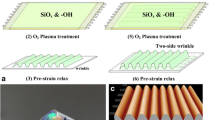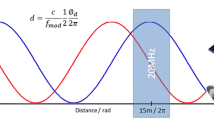Abstract
Ultra-lightweight spacecraft incorporating “gossamer” structures are extremely compliant, which complicates control, design, and ground testing in full scale. One approach to model the behavior of a full-scale gossamer structure is to construct a small-scale model test article that can be used to verify a corresponding small-scale computer model. Once the predictions of the computer model have been verified by measurement of the physical test article, it can be scaled up to allow computation of the full-scale structure behavior. As model verification requires accurate deflection measurements at multiple points along the surface of the structure, a sensing system that provides full-field data without changing the dynamic response of the structure must be developed. Hence, an optical approach is taken. Since the thin films used in gossamer space structures are typically smooth and featureless, targets must be incorporated into the film surface to enable tracking of both in-plane and out-of-plane displacements. A krypton fluoride excimer laser system was used to etch 35 μm wide linear features approximately 0.1 μm into the surface metallization of both 50.8 μm polyester and 127 μm polyimide films. These optically diffuse surface features, designed mainly to investigate the precision of the laser etching method, were used as targets for ultra-close-range photogrammetry, the method chosen for displacement tracking. A force applied to the surface of the etched mirror (test article) produced in-plane and out-of-plane deformations that were resolved via ultra-close-range photogrammetry. To measure the in-plane tracking resolution, 1.5 and 3.0 mm circular dots were added (using ink) to the surface of the thin film, and some of these targets were tracked as the test article was translated on a precision linear stage. In-plane tracking resolution using ultra-close-range photogrammetry was related to the ground sample distance of the camera, which in this case was 51.25 μm pixel−1 (equal to the ratio of sample dimension to number of pixels in the field of view). Using a manual technique to identify features of the etched pattern for tracking, the mean tracking error was about 13 μm (σ=43 μm). Using an automated, subpixel marking technique to identify the 1.5 mm circular targets, the mean tracking error was 22 μm (σ=13 μm). Neither of these methods achieved the desired 10 μm tracking resolution.
Similar content being viewed by others
References
Thota, P., “Pattern Evaluation for In-plane Displacement of Thin Films,” MS Thesis, Department of Mechanical Engineering, University of Kentucky (2003).
Schmidt, T., Tyson, J., and Galanulis, K., “Dynamic Strain Measurement Using Advanced 3D Photogrammetry,” Proceedings of the 21st International Modal Analysis Conference, Orlando, FL, February (2003).
Mikhail, E.M., Betherl, J.S. andMcGlone, J.C., Introduction to Modern Photogrammetry, Wiley, New York (2001).
Photomodeler Pro-User Manual, Eos Systems Inc., Vancouver, BC, Canada.
Shortis, M.R. andBeyer, H.A., “Sensor Technology for Close Range Photogrammetry and Machine Vision,”Close Range Photogrammetry and Machine Vision, K.B. Atkinson editor, Whittles Publishing, Caithness, Scotland, 106–155 (2000).
L'Garde, Inc., Photogrammetry Capability, http://www.lgarde.com/capabilities/photo.html.
Dharamsi, U.K., Evanchik, D.M., and Blandino, J.R., “Comparing Photogrammetry with a Conventional Displacement Measurement Technique on a Square Kapton Membrane,”, Paper 2002-1258, Proceedings of the 3rd AIAA Gossamer Structures Forum, Denver, CO, April (2002).
Jenkins, C.H., Haugen, F., andSpicher, W.H., “Experimental Measurement of Wrinkling in Membranes Undergoing Planar Deformation,”EXPERIMENTAL MECHANICS,38 (2),147–152 (1998).
Jenkins, C.H., Fitzgerald, D.M., and Liu, X., “Wrinkling of an Inflatable Membrane with Thermoelastic Boundary Conditions,” Paper 2000-1727, Proceedings of the 1st AIAA Gossamer Structures Forum, Atlanta, GA, April (2000).
Blandino, J.R., Johnston, J.D., Miles, J.J., and Soplop, J.S., “Thinfilm Membrane Wrinkling due to Thermal and Mechanical Loads,” Paper 2001-1345, Proceedings of the 2nd AIAA Gossamer Structures Forum, Seattle, WA, April (2001).
Black, J.T. and Pappa, R.S., “Videogrammetry Using Projected Circular Targets: Proof-of-concept Test,” Proceedings of the 21st International Modal Analysis Conference, Kissimmee, FL, February (2003).
Pappa, R.S., Black, J.T., Blandino, J.R., Jones, T.W., Danehy, P.M., and Dorrington, A.A., “Dot-projection Photogrammetry and Videogrammetry of Gossamer Space Structures”, NASA/TM-2003-212146, January (2003).
Rosato, D.V. andSchwartz, R.T., editors, Environmental Effects on Polymeric Materials, Interscience, New York (1968).
Author information
Authors and Affiliations
Rights and permissions
About this article
Cite this article
Thota, P., Leifer, J., Smith, S.W. et al. Pattern evaluation for in-plane displacement measurement of thin films. Experimental Mechanics 45, 18–26 (2005). https://doi.org/10.1007/BF02428986
Received:
Accepted:
Issue Date:
DOI: https://doi.org/10.1007/BF02428986




